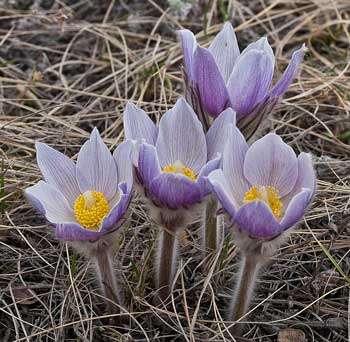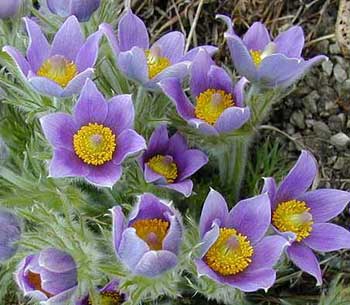Contents:
Common Names | Parts Usually Used | Plant(s) & Culture | Where Found | Medicinal Properties
Legends, Myths and Stories | Uses | Warning | Bibliography
Scientific Names

- Anemone patens L.
- Anemone pulsatilla
- Pulsatilla Vulgaris
- Ranunculaceae
- Buttercup family
Common Names
Anemone patens common names:
- Easter flower
- Meadow anemone
- Wild crocus
- Wind flower
Pulsatilla vulgaris common names:
- Easter flower
- Pulsatilla
Parts Usually Used
Anemone patens: Whole plant
Pulsatilla vulgaris: Root
Back to Top

Description of Plant(s) and Culture
Anemone patens:
A perennial plant, the stem grows from 6-16 inches high and bears alternate, palmately dissected leaves with narrow, linear lobes. A solitary, terminal, erect flower features 5-6 petal-like, purplish-blue to whitish sepals, blooming in March and April.
Pulsatilla vulgaris:
A North American wildflower of early spring, having silky, hairy foliage and cup-shaped, bluish, solitary flowers. Grow it close to a front walk or in a rock garden to enjoy its low flowers up close. It has been renamed Anemone pulsatilla. Plant is 1 foot tall and produces ferny leaves and purple campanulate flowers; entire plant is covered with silky hair. Full sun. Zones 6-9. Not heat tolerant.
Pasque flower will do well in any well-drained, dryish soil in full sun. Start from firm, thick rootstock, planted in the fall, with the top of the rootstock at the soil surface. Or start from seed, sowing as soon as the seed head ripens, placing seedlings in their permanent place in the spring. Set 8-12 inches apart in informal massings. Seedlings will bloom in 2 years. Apply fertilizer at the beginning of the growing season, and peat or leaf mold in the fall. Keep young plants weed-free so they can develop a good rootstock. Cut off old leaves in the spring. Pasque flower is highly disease-resistant, but the rootstock will rot in wet conditions. Winter frost protection is not needed. There is also a white-flowered form, (Alba).
Back to Top
Where Found
Anemone patens:
A perennial plant found on dry prairies, moist meadows, and woods from Illinois and Wisconsin to Texas, westward and northwestward, north to Alaska.
Pulsatilla vulgaris:
This pasque flower is native to northern and central Europe and western Asia.
Back to Top
Medicinal Properties
Anemone patens: Diaphoretic, diuretic, nervine, rubefacient (causing redness of the skin).
Pulsatilla vulgaris: Stimulant
Back to Top
Legends, Myths and Stories
This very beautiful, perennial, early-flowering herb was given its common name (pasque is Old French for Easter) because it flowers near Easter, and it was once used to color Easter eggs.
The Blackfeet Indians called pasque flower “Napi” and used the leaves as a poultice as a counter-irritant for rheumatism.
Back to Top
Uses
Anemone patens:
The fresh plant is the most active, but it is also highly irritating both externally and internally. The dried, powdered Pasque Flower plant is sometimes used to promote the healing of wounds. Minute doses diluted in water have been used internally in homeopathic practice for eye ailments, earache, stress, anxiety, tension, skin eruptions, rheumatism, leukorrhea, obstructed menses, bronchitis, coughs, asthma.
Pulsatilla vulgaris:
This pasque flower contains a poison that causes skin irritation and violent convulsions. It is used in homeopathic remedies. Grow only to enjoy its lovely purple bell-shaped flowers in early spring, and keep children away from the plantings.
Back to Top
Warning
Anemone patens:
Pasque flower contains alkaloids that cause depression, nervousness, and stomach upset, and which may be fatal if consumed in large quantities.
Poisonous. Extremely irritating.
Do not use without medical supervision.
Pulsatilla vulgaris:
Considered poisonous. This pasque flower contains a poison that causes skin irritation and violent convulsions.
Care should be taken. Use only under medical supervision.
Back to Top
Bibliography
![]() The Herb Book
The Herb Book, by John Lust, Bantam Books, 666 Fifth Avenue, New York, NY. copyright 1974.
![]() The Complete Medicinal Herbal
The Complete Medicinal Herbal, by Penelope Ody, Dorling Kindersley, Inc, 232 Madison Avenue, New York, NY 10016, First American Edition, copyright 1993
![]() Eastern/Central Medicinal Plants
Eastern/Central Medicinal Plants, by Steven Foster and James A. Duke., Houghton Mifflin Company, 215 Park Avenue South, New York, NY 10000
![]() The Nature Doctor: A Manual of Traditional and Complementary Medicine
The Nature Doctor: A Manual of Traditional and Complementary Medicine, by Dr. H.C.A. Vogel; Keats Publishing, Inc., 27 Pine Street (Box 876) New Canaan, CT. 06840-0876. Copyright Verlag A. Vogel, Teufen (AR) Switzerland 1952, 1991
![]() Indian Uses of Native Plants
Indian Uses of Native Plants, by Edith Van Allen Murphey, Meyerbooks, publisher, PO Box 427, Glenwood, Illinois 60425, copyright 1958, print 1990
 Prairie Smoke
Prairie Smoke, by Melvin R. Gilmore, Minnesota Historical Society Press, St. Paul, Minnesota 55101, copyright 1987.
Herbal Gardening, compiled by The Robison York State Herb Garden, Cornell Plantations, Matthaei Botanical Gardens of the University of Michigan, University of California Botanical Garden, Berkeley., Pantheon Books, Knopf Publishing Group, New York, 1994, first edition
 How Indians Use Wild Plants for Food, Medicine & Crafts
How Indians Use Wild Plants for Food, Medicine & Crafts, by Frances Densmore, Dover Publications, Inc., 180 Varick Street, New York, NY 10014, first printed by the United States Government Printing Office, Washington, in 1928, this Dover edition 1974
 Taber’s Cyclopedic Medical Dictionary
Taber’s Cyclopedic Medical Dictionary, 15th Edition, F. A. Davis Company, 1915 Arch Street, Philadelphia, PA 19103
![]() Webster’s New World Dictionary
Webster’s New World Dictionary, Third College Edition, Victoria Neufeldt, Editor in Chief, New World Dictionaries: A Division of Simon & Schuster, Inc., 15 Columbus Circle, New York, NY 10023
